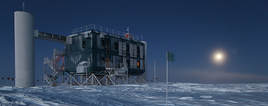
Quantum physics has stood the test of time in consistently unearthing challenges to the scientific mindset. From early days of its conception when Schroedinger famously placed a cat in a situation of superposition, the spectrum has widened considerably. These days, wave-particle duality and the Everett interpretation are well-worn familiars in the subatomic sector, and while they have lost none of their charm, their strange implications are accepted even if the actuality they represent remains poorly understood.

The Standard Model didn't leave any room for oscillating neutrinos, but now that they're here, it's had to be said that they are relatively massive. While being massive, they still manage to pass through most matter unhindered. However big or small a neutrino may be, its passage through you, me, and everything around us seems undeterred. As far as we know at this point in time, there is very little interaction taking place. But that's as far as we know for the time being, and as we know, the things we know can turn on a tanner very easily indeed.
The peculiar placement of quark-gluon plasma has made oscillation an apparent feature of particles we're made of, too, for quarks are fundamental to all states of matter. But they, too, are something of an enigma. While QCD lends the colour spectrum to quark behaviour and helps the maths to add up to something making observable sense, quite why quarks oscillate as they do remains a complete mystery. The maths says that Up and Down quarks comprise the fabric most commonplace but then it was commonly believed that the Muon neutrino was the staple composite of everything until oscillation came along to destabilise the notion that neutrinos held their flavour for any length of time.

New experiments like IceCube and ORCA are built to measure neutrinos of cosmic origin and so, for the first time, the Tau is making a regular appearance on the scientific stage. But as is now evident, that's not to say the Tau neutrino hasn't been flying through us in unfathomable numbers on a continuous basis; only that it's managed to do so unseen, so far.
Now, they say in all notable circles that trusting your gut is crucial. And right from the earliest days of my dalliance with neutrino physics, my gut screamed loudly at me that the Tau was very important. This was before I realised that it was the most massive of the neutrino family, that it was very high-energy, and that like the Beauty and Truth quarks, was said to be short-lived. The last of these is open to question in knowing more about the secret life of the lepton, as science begins to stitch together evidence to suggest that connections are more than the sums they seem to be.
Much breath is being held on the possibility of Majorana coming true, too, which would mean that neutrinos are matter and antimatter at the same time, and if as the double-slit experiment subtly suggests, particles have some ingenious instinct for the things they are about to encounter, perhaps the neutrino sheds its matter status and steathily, without any danger of annihilation, becomes its antimatter self when it passes through atomic material. If so, this would raise fundamental questions of annihilation, and show the electron to be a theatrical narcissist when it comes to creating plausible theories of how the Universe works. For far from being dominated by negatively-charged particles, we might find ourselves free to choose from the options of oscillation in taking our places in life to a new level, in determining our own mind-set according to the nature of the forces and particles with which we may be blessed to interact.
 RSS Feed
RSS Feed
